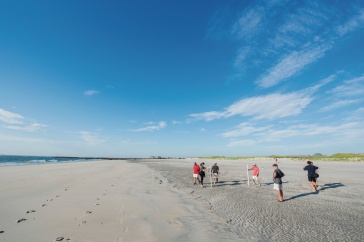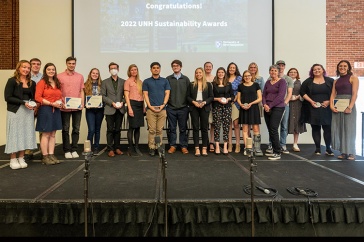
Walk along a beach in New England, and chances are you’ll encounter piles of fine red seaweed washed up in drifts at the waterline. While it may look harmless enough, the fiber-like weed, Dasysiphonia japonica, is a harbinger of sweeping changes in the marine environment occurring beneath the water. UNH researchers studying 30 years of seaweed populations have found that the southwestern Gulf of Maine’s once-predominant and towering kelp seaweed beds are declining, and more invasive, shrub-like species have taken their place, altering the look of the ocean floor and the base of the marine food chain.
“We were very surprised by what we saw. In some areas, what was once a forest of tall blades of kelp with a high canopy height is now composed of bushy invasive seaweed species.”
In a study recently published in the Journal of Ecology, researchers compared photos of sections of the seafloor collected over 30 years at several subtidal sites in the southwestern Gulf of Maine. They also collected individual seaweed species to determine their complexity and the biodiversity of meso-invertebrates — smaller ocean species that fish and shellfish, such as crabs, feed on — associated with each seaweed species. The data show that the seaweed community, as well as the number and types of small creatures, has changed significantly. Dasysiphonia japonica now covers up to 90 percent of some areas, altering the visual landscape, and the newly created habitat structure supports two to three times more small creatures at the base of the food chain.
“We were very surprised by what we saw,” says lead author Jennifer Dijkstra, a research assistant professor in UNH’s Center for Coastal and Ocean Mapping. “In some areas, what was once a forest of tall blades of kelp with a high canopy height is now composed of bushy invasive seaweed species.”
Studies have found that kelp forests are one of the most productive systems in the ocean, boasting high biodiversity and ecological function. Large, New England-native species like sugar kelp and oarweed offer protection and harbor a source of food for juvenile species of fish including pollock, cod and flounder; juvenile and adult lobsters; and crabs, seals and birds.
Dijkstra says that while the changing seascape has dramatically altered and increased the diversity and number of small creatures at the base of the marine food web, it’s unknown if these changes in the ecosystem will propagate through the entire chain. “Even though there may be more creatures at the base, it’s not clear what their effects will be on fish or other crabs in the habitat and how much protection the new landscape will provide,” she says.
Dijkstra and her team are currently conducting studies that look at the effects of invasive seaweed species and why they are increasing in the Gulf of Maine. Researchers speculate that a number of events that relate to historical fishing practices, both commercial and recreational, combined with the warming waters in the Gulf of Maine may be negatively impacting the growth of kelp.
Originally published in UNH Magazine Fall 2017 Issue
-
Written By:
Robbin Ray ’82 | UNH Marketing | robbin.ray@unh.edu | 603-862-4864




















































